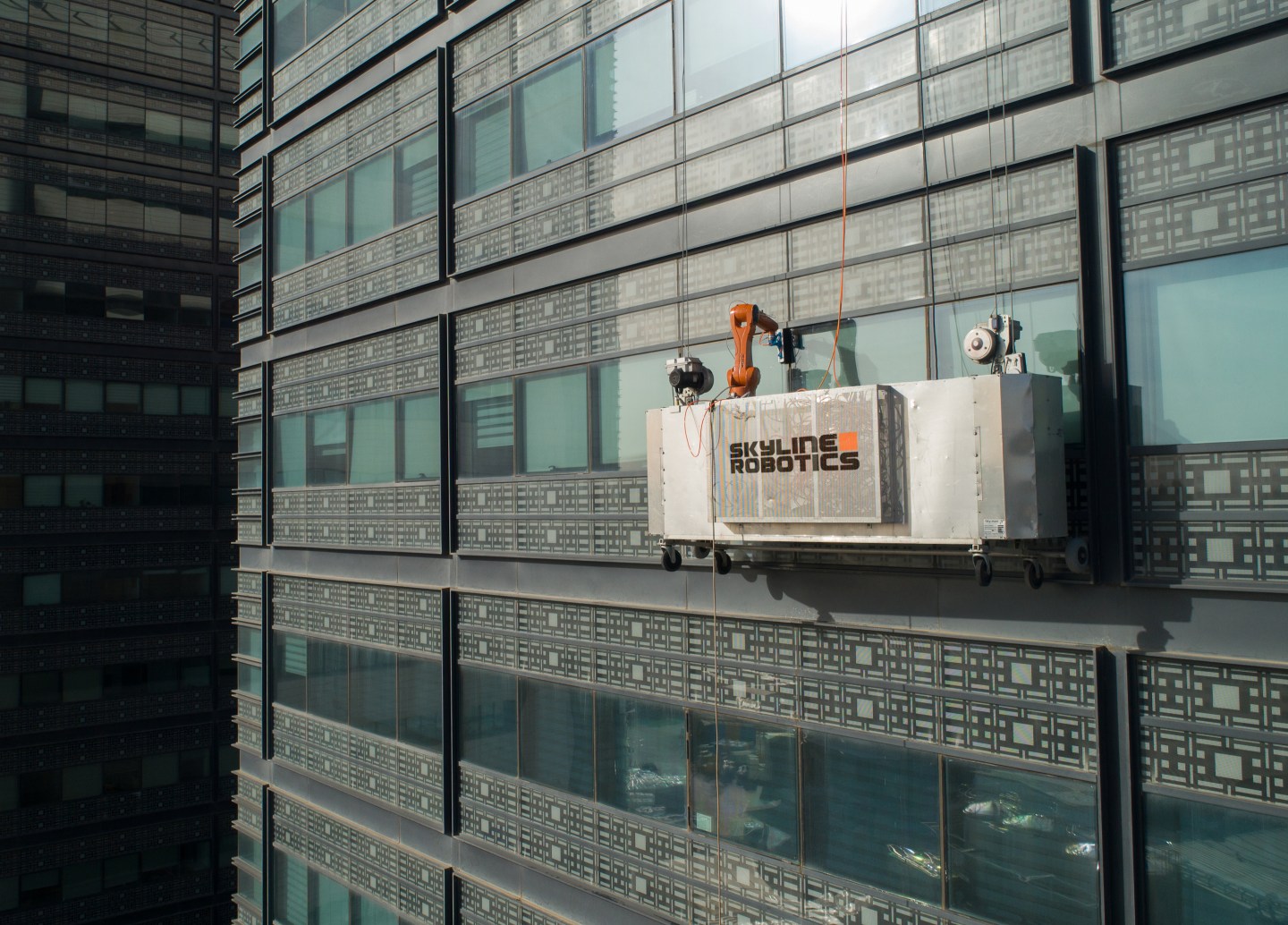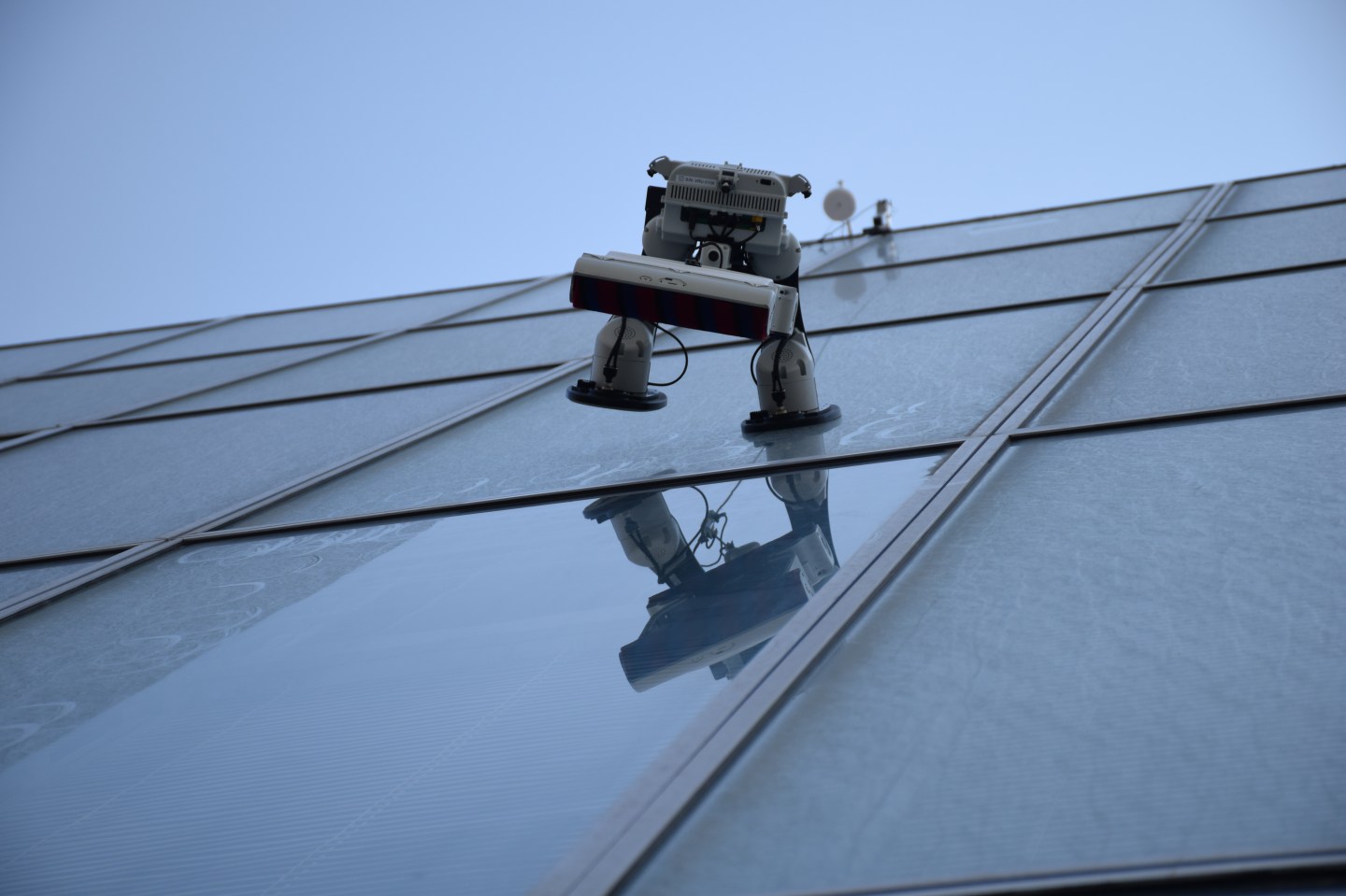
2023年5月,我來(lái)到了全世界最高的住宅樓——美國(guó)紐約州紐約市中央公園大廈(Central Park Tower)頂層的露臺(tái),。這棟大廈坐落在所謂的“富豪街”上,,它也是全世界最高的建筑之一,其外墻材料主要是玻璃,。我站在離地面1,416英尺(約431.597米)高的露臺(tái)上,,一邊喝著香檳一邊想:這么高的大樓,這些窗子得怎么才能夠擦干凈呀,?
大樓外層清潔這種工作雖然危險(xiǎn),,但終歸是要有人做的。不過(guò)對(duì)于這種超高層的摩天大樓來(lái)說(shuō),,做這份工作的有時(shí)竟然是機(jī)器人,。
現(xiàn)在,,有兩家名叫Verobotics和Skyline Robotics的公司都盯上了規(guī)模達(dá)400億美元的大樓外墻清潔市場(chǎng)。這兩家公司打算利用人工智能機(jī)器人來(lái)模擬人類(lèi)擦窗工人,,從而讓這份工作變得更加安全和高效,。這種技術(shù)同時(shí)也可以應(yīng)用于其他垂直墻面的維修保養(yǎng)。這兩家公司都認(rèn)為,,通過(guò)將人工智能與硬件結(jié)合,,這種技術(shù)在鋼鐵叢林般的城市中必然大有可為。
Verobotics公司的聯(lián)合創(chuàng)始人及首席執(zhí)行官伊多·吉諾薩說(shuō):“一棟建筑物的外層會(huì)對(duì)建筑物起到類(lèi)似皮膚的保護(hù)作用,,因此它也是建筑物的一個(gè)重要組成部分,,它不僅關(guān)乎居住者的健康,也關(guān)乎建筑物的能源效率,。不過(guò)令人意外的是,,在過(guò)去一個(gè)世紀(jì)里,建筑物的外層維護(hù)技術(shù)幾乎沒(méi)有什么創(chuàng)新,,只是維護(hù)成本變得越來(lái)越高,。而我們的目標(biāo)就是積極解決高樓大廈的維修保養(yǎng)問(wèn)題,保護(hù)好城市高樓的‘皮膚’,?!?/p>
該公司的機(jī)器人名為Ibex——這也是阿爾卑斯山地區(qū)的一種極善攀爬的野山羊的名字。這款機(jī)器人長(zhǎng)得很像iRobot公司出品的一款全自動(dòng)家用掃地機(jī)器人Roomba,,但是二者的功能完全不同,。Ibex有兩條腿、5個(gè)攝像頭和15個(gè)傳感器,,它能夠在垂直墻面上自行攀爬,,并且把自己固定在垂直墻面上。它還搭載了一個(gè)特殊的清潔模塊,,可以使用定制的刷子對(duì)大樓外墻進(jìn)行清潔,。只需一名操作員就能夠控制四個(gè)Ibex機(jī)器人同時(shí)在大樓上進(jìn)行外墻清潔工作。
當(dāng)機(jī)器人進(jìn)行清潔工作時(shí),,它還會(huì)使用多個(gè)傳感器獲取的原始數(shù)據(jù)來(lái)構(gòu)建該建筑物的實(shí)時(shí)3D地圖,,包括它的詳細(xì)狀態(tài)。吉薩諾介紹道,,如果在一年之內(nèi)定期使用該機(jī)器人進(jìn)行清潔的話,,那么它還會(huì)及時(shí)更新該建筑物外層的變化,并且指出潛在問(wèn)題,,這樣的話,,我們就可以及時(shí)介入維修,免得“小洞不補(bǔ)大洞吃苦”,。
吉諾薩說(shuō):“我們的機(jī)器人能夠利用人工智能收集關(guān)于大樓外墻健康情況的系統(tǒng)性和一致性數(shù)據(jù),,使業(yè)主可以據(jù)此主動(dòng)開(kāi)展維保工作,,并且根據(jù)問(wèn)題嚴(yán)重程度提前做出維修計(jì)劃,從而顯著降低大樓外墻的維保成本,?!?/p>
吉諾薩稱(chēng),他的家族原本就是做建筑行業(yè)的,,正是因?yàn)榭吹搅舜髽蔷S保方面存在的局限性,,他和公司的另一位創(chuàng)始人、首席技術(shù)官伊塔依·列維坦才開(kāi)發(fā)了這套機(jī)器人系統(tǒng),。以前的外墻維保方案存在笨重昂貴,、操作不便等缺點(diǎn),另外,,它們也沒(méi)有為很多城市面臨的氣候變化問(wèn)題做好準(zhǔn)備,。畢竟全球60%的最高建筑都是在過(guò)去13年中建成的。
吉諾薩指出,,近年來(lái),全球極端天氣事件的發(fā)生頻率有所增加,,比如臺(tái)風(fēng),、暴雨等等,它們都會(huì)對(duì)建筑物造成影響,。另一方面,,在大風(fēng)、高溫,、烈日等天氣條件下進(jìn)行大樓外墻的清潔工作,,對(duì)工人而言也會(huì)更加危險(xiǎn)。他表示,,現(xiàn)在他的公司的大部分業(yè)務(wù)都集中在中國(guó)香港,、新加坡、韓國(guó)首爾和日本東京等高樓大廈林立的城市,。

而在美國(guó)紐約和英國(guó)倫敦,,另一家名叫Skyline Robotics的公司也在思考如何在外墻維保領(lǐng)域?qū)崿F(xiàn)創(chuàng)新。該公司于2023年10月剛剛在倫敦成立,,但是現(xiàn)在,,你已經(jīng)能夠在曼哈頓的哈德遜廣場(chǎng)10號(hào)(10 Hudson Yards)和世貿(mào)中心7號(hào)(7 World Trade Center)等高樓大廈上看到它的機(jī)器人了。
Skyline公司的機(jī)器人名叫Ozmo,,它的機(jī)械臂可以模仿人類(lèi)的動(dòng)作,,而且它的擦窗速度是人類(lèi)的三倍,。Skyline公司的總裁兼首席運(yùn)營(yíng)官羅斯·布魯姆表示,Ozmo能夠?qū)F(xiàn)場(chǎng)勞動(dòng)力成本降低75%,。
更重要的是,,這些機(jī)器人還有助于解決高空作業(yè)人員短缺的問(wèn)題,這也是擺在行業(yè)面前的一個(gè)現(xiàn)實(shí)困難,。在百米高空擦玻璃顯然是一項(xiàng)極其危險(xiǎn)的工作,,這就是為什么只有9%的高空擦窗工人的年齡在20歲至30歲之間。絕大多數(shù)高空作業(yè)工人的年紀(jì)都在40歲以上,,而且他們都傾向于早早退休,。
“他們必須把自己吊在離地1,000英尺(304.8米)的空中,做繁重的體力勞動(dòng),,那里的溫度可能是4攝氏度,,也可能是40攝氏度。但無(wú)論如何,,他們都必須完成自己的工作,。”布魯姆說(shuō),,“而且現(xiàn)實(shí)情況是,,這項(xiàng)工作的待遇也不是特別高,下一代也不愿意從事這項(xiàng)工作,?!?/p>
布魯姆指出,機(jī)器人為年輕工人帶來(lái)了一種新的刺激——學(xué)習(xí)新技術(shù),,獲得一種可以轉(zhuǎn)化的技能,。例如有了Skyline機(jī)器人后,擦窗工人現(xiàn)在已經(jīng)能夠和機(jī)器人協(xié)同工作了,?!拔覀兊募夹g(shù)不可能100%取代人類(lèi),人類(lèi)總是有用武之地的,?!?/p>
Ozmo搭載了一個(gè)六軸機(jī)械臂,其機(jī)械結(jié)構(gòu)類(lèi)似于人類(lèi)的手臂關(guān)節(jié)結(jié)構(gòu),。這款機(jī)器人是固定在一個(gè)工作臺(tái)上的,,而工作臺(tái)則通過(guò)起重機(jī)或者吊架系統(tǒng)從屋頂上懸垂下來(lái)。遠(yuǎn)遠(yuǎn)看去,,你甚至可能以為你頭上有兩名正在擦窗戶(hù)的工人,。但實(shí)際上,人類(lèi)操控員是可以在大樓里面進(jìn)行操控的,也能夠在樓頂進(jìn)行操控,。
Ozmo的大部分決策都可以獨(dú)自完成,。它每秒鐘能夠計(jì)算250次,計(jì)算內(nèi)容包括清潔時(shí)使用多大的壓力,,在哪里需要用刷子刷,,以及什么時(shí)候把腳手架移動(dòng)到下面一層。所有這些都是為了確定最有效的清潔路徑,。它還會(huì)評(píng)估建筑物的外層情況,,并且就需要解決的問(wèn)題提交數(shù)據(jù)。
布魯姆表示,,機(jī)器人節(jié)省下來(lái)的成本,,以及收集的額外數(shù)據(jù),對(duì)于維持這些高樓大廈的健康十分重要,。有了這些機(jī)器人,,大樓業(yè)主們就可以更經(jīng)常地對(duì)大樓外層進(jìn)行清潔、拋光和檢查,,并且科學(xué)地規(guī)化建設(shè)和維保項(xiàng)目?,F(xiàn)在大多數(shù)高樓大廈的墻面檢修周期是10年至15年,但布魯姆相信,,只要有條件,,多數(shù)大樓的業(yè)主是希望縮短這個(gè)檢修周期的。
“一個(gè)建筑物的預(yù)算大約有10%到20%分配給了墻面,。換句話說(shuō),如果一棟大樓的造價(jià)是10億美元,,墻面就占2億美元,。墻面是大樓的臉面,所以你需要更經(jīng)常地檢修一下,?!?/p>
比如,光是紐約市就有7,000多座高層建筑,,其中高度超過(guò)650英尺(198.12米)的就有100座以上,,超過(guò)1,000英尺(304.8米)的有16座。從我辦公室的窗戶(hù)向外望去,,我就能夠看見(jiàn)一座高達(dá)850英尺(259.08米)的新住宅樓的樓頂,。它的外墻肯定時(shí)不時(shí)也需要清洗。
“如果有人在80層的位置買(mǎi)房,,那他買(mǎi)的是在這個(gè)高度可以看到的景觀,。那么他們就必須得到一扇干凈的窗子?!辈剪斈氛f(shuō)道,。(財(cái)富中文網(wǎng))
譯者:樸成奎
2023年5月,,我來(lái)到了全世界最高的住宅樓——美國(guó)紐約州紐約市中央公園大廈(Central Park Tower)頂層的露臺(tái)。這棟大廈坐落在所謂的“富豪街”上,,它也是全世界最高的建筑之一,,其外墻材料主要是玻璃。我站在離地面1,416英尺(約431.597米)高的露臺(tái)上,,一邊喝著香檳一邊想:這么高的大樓,,這些窗子得怎么才能夠擦干凈呀?
大樓外層清潔這種工作雖然危險(xiǎn),,但終歸是要有人做的,。不過(guò)對(duì)于這種超高層的摩天大樓來(lái)說(shuō),做這份工作的有時(shí)竟然是機(jī)器人,。
現(xiàn)在,,有兩家名叫Verobotics和Skyline Robotics的公司都盯上了規(guī)模達(dá)400億美元的大樓外墻清潔市場(chǎng)。這兩家公司打算利用人工智能機(jī)器人來(lái)模擬人類(lèi)擦窗工人,,從而讓這份工作變得更加安全和高效,。這種技術(shù)同時(shí)也可以應(yīng)用于其他垂直墻面的維修保養(yǎng)。這兩家公司都認(rèn)為,,通過(guò)將人工智能與硬件結(jié)合,,這種技術(shù)在鋼鐵叢林般的城市中必然大有可為。
Verobotics公司的聯(lián)合創(chuàng)始人及首席執(zhí)行官伊多·吉諾薩說(shuō):“一棟建筑物的外層會(huì)對(duì)建筑物起到類(lèi)似皮膚的保護(hù)作用,,因此它也是建筑物的一個(gè)重要組成部分,,它不僅關(guān)乎居住者的健康,也關(guān)乎建筑物的能源效率,。不過(guò)令人意外的是,,在過(guò)去一個(gè)世紀(jì)里,建筑物的外層維護(hù)技術(shù)幾乎沒(méi)有什么創(chuàng)新,,只是維護(hù)成本變得越來(lái)越高,。而我們的目標(biāo)就是積極解決高樓大廈的維修保養(yǎng)問(wèn)題,保護(hù)好城市高樓的‘皮膚’,?!?/p>
該公司的機(jī)器人名為Ibex——這也是阿爾卑斯山地區(qū)的一種極善攀爬的野山羊的名字。這款機(jī)器人長(zhǎng)得很像iRobot公司出品的一款全自動(dòng)家用掃地機(jī)器人Roomba,,但是二者的功能完全不同,。Ibex有兩條腿、5個(gè)攝像頭和15個(gè)傳感器,,它能夠在垂直墻面上自行攀爬,,并且把自己固定在垂直墻面上。它還搭載了一個(gè)特殊的清潔模塊,可以使用定制的刷子對(duì)大樓外墻進(jìn)行清潔,。只需一名操作員就能夠控制四個(gè)Ibex機(jī)器人同時(shí)在大樓上進(jìn)行外墻清潔工作,。
當(dāng)機(jī)器人進(jìn)行清潔工作時(shí),它還會(huì)使用多個(gè)傳感器獲取的原始數(shù)據(jù)來(lái)構(gòu)建該建筑物的實(shí)時(shí)3D地圖,,包括它的詳細(xì)狀態(tài),。吉薩諾介紹道,如果在一年之內(nèi)定期使用該機(jī)器人進(jìn)行清潔的話,,那么它還會(huì)及時(shí)更新該建筑物外層的變化,,并且指出潛在問(wèn)題,這樣的話,,我們就可以及時(shí)介入維修,,免得“小洞不補(bǔ)大洞吃苦”。
吉諾薩說(shuō):“我們的機(jī)器人能夠利用人工智能收集關(guān)于大樓外墻健康情況的系統(tǒng)性和一致性數(shù)據(jù),,使業(yè)主可以據(jù)此主動(dòng)開(kāi)展維保工作,,并且根據(jù)問(wèn)題嚴(yán)重程度提前做出維修計(jì)劃,從而顯著降低大樓外墻的維保成本,?!?/p>
吉諾薩稱(chēng),他的家族原本就是做建筑行業(yè)的,,正是因?yàn)榭吹搅舜髽蔷S保方面存在的局限性,,他和公司的另一位創(chuàng)始人、首席技術(shù)官伊塔依·列維坦才開(kāi)發(fā)了這套機(jī)器人系統(tǒng),。以前的外墻維保方案存在笨重昂貴,、操作不便等缺點(diǎn),另外,,它們也沒(méi)有為很多城市面臨的氣候變化問(wèn)題做好準(zhǔn)備,。畢竟全球60%的最高建筑都是在過(guò)去13年中建成的。
吉諾薩指出,,近年來(lái),全球極端天氣事件的發(fā)生頻率有所增加,,比如臺(tái)風(fēng),、暴雨等等,它們都會(huì)對(duì)建筑物造成影響,。另一方面,,在大風(fēng)、高溫,、烈日等天氣條件下進(jìn)行大樓外墻的清潔工作,,對(duì)工人而言也會(huì)更加危險(xiǎn)。他表示,現(xiàn)在他的公司的大部分業(yè)務(wù)都集中在中國(guó)香港,、新加坡,、韓國(guó)首爾和日本東京等高樓大廈林立的城市。
而在美國(guó)紐約和英國(guó)倫敦,,另一家名叫Skyline Robotics的公司也在思考如何在外墻維保領(lǐng)域?qū)崿F(xiàn)創(chuàng)新,。該公司于2023年10月剛剛在倫敦成立,但是現(xiàn)在,,你已經(jīng)能夠在曼哈頓的哈德遜廣場(chǎng)10號(hào)(10 Hudson Yards)和世貿(mào)中心7號(hào)(7 World Trade Center)等高樓大廈上看到它的機(jī)器人了,。
Skyline公司的機(jī)器人名叫Ozmo,它的機(jī)械臂可以模仿人類(lèi)的動(dòng)作,,而且它的擦窗速度是人類(lèi)的三倍,。Skyline公司的總裁兼首席運(yùn)營(yíng)官羅斯·布魯姆表示,Ozmo能夠?qū)F(xiàn)場(chǎng)勞動(dòng)力成本降低75%,。
更重要的是,,這些機(jī)器人還有助于解決高空作業(yè)人員短缺的問(wèn)題,這也是擺在行業(yè)面前的一個(gè)現(xiàn)實(shí)困難,。在百米高空擦玻璃顯然是一項(xiàng)極其危險(xiǎn)的工作,,這就是為什么只有9%的高空擦窗工人的年齡在20歲至30歲之間。絕大多數(shù)高空作業(yè)工人的年紀(jì)都在40歲以上,,而且他們都傾向于早早退休,。
“他們必須把自己吊在離地1,000英尺(304.8米)的空中,做繁重的體力勞動(dòng),,那里的溫度可能是4攝氏度,,也可能是40攝氏度。但無(wú)論如何,,他們都必須完成自己的工作,。”布魯姆說(shuō),,“而且現(xiàn)實(shí)情況是,,這項(xiàng)工作的待遇也不是特別高,下一代也不愿意從事這項(xiàng)工作,?!?/p>
布魯姆指出,機(jī)器人為年輕工人帶來(lái)了一種新的刺激——學(xué)習(xí)新技術(shù),,獲得一種可以轉(zhuǎn)化的技能,。例如有了Skyline機(jī)器人后,擦窗工人現(xiàn)在已經(jīng)能夠和機(jī)器人協(xié)同工作了,?!拔覀兊募夹g(shù)不可能100%取代人類(lèi),,人類(lèi)總是有用武之地的?!?/p>
Ozmo搭載了一個(gè)六軸機(jī)械臂,,其機(jī)械結(jié)構(gòu)類(lèi)似于人類(lèi)的手臂關(guān)節(jié)結(jié)構(gòu)。這款機(jī)器人是固定在一個(gè)工作臺(tái)上的,,而工作臺(tái)則通過(guò)起重機(jī)或者吊架系統(tǒng)從屋頂上懸垂下來(lái),。遠(yuǎn)遠(yuǎn)看去,你甚至可能以為你頭上有兩名正在擦窗戶(hù)的工人,。但實(shí)際上,,人類(lèi)操控員是可以在大樓里面進(jìn)行操控的,也能夠在樓頂進(jìn)行操控,。
Ozmo的大部分決策都可以獨(dú)自完成,。它每秒鐘能夠計(jì)算250次,計(jì)算內(nèi)容包括清潔時(shí)使用多大的壓力,,在哪里需要用刷子刷,,以及什么時(shí)候把腳手架移動(dòng)到下面一層。所有這些都是為了確定最有效的清潔路徑,。它還會(huì)評(píng)估建筑物的外層情況,,并且就需要解決的問(wèn)題提交數(shù)據(jù)。
布魯姆表示,,機(jī)器人節(jié)省下來(lái)的成本,,以及收集的額外數(shù)據(jù),對(duì)于維持這些高樓大廈的健康十分重要,。有了這些機(jī)器人,,大樓業(yè)主們就可以更經(jīng)常地對(duì)大樓外層進(jìn)行清潔、拋光和檢查,,并且科學(xué)地規(guī)化建設(shè)和維保項(xiàng)目?,F(xiàn)在大多數(shù)高樓大廈的墻面檢修周期是10年至15年,但布魯姆相信,,只要有條件,,多數(shù)大樓的業(yè)主是希望縮短這個(gè)檢修周期的。
“一個(gè)建筑物的預(yù)算大約有10%到20%分配給了墻面,。換句話說(shuō),,如果一棟大樓的造價(jià)是10億美元,墻面就占2億美元,。墻面是大樓的臉面,,所以你需要更經(jīng)常地檢修一下,?!?/p>
比如,,光是紐約市就有7,000多座高層建筑,其中高度超過(guò)650英尺(198.12米)的就有100座以上,,超過(guò)1,000英尺(304.8米)的有16座,。從我辦公室的窗戶(hù)向外望去,我就能夠看見(jiàn)一座高達(dá)850英尺(259.08米)的新住宅樓的樓頂,。它的外墻肯定時(shí)不時(shí)也需要清洗,。
“如果有人在80層的位置買(mǎi)房,那他買(mǎi)的是在這個(gè)高度可以看到的景觀,。那么他們就必須得到一扇干凈的窗子,。”布魯姆說(shuō)道,。(財(cái)富中文網(wǎng))
譯者:樸成奎
In May, I set foot on the highest residential terrace in the world, the outdoor space of the penthouse at the Central Park Tower in New York City. A part of the so-called Billionaires’ Row, Central Park Tower is among the tallest buildings in the world, and its exterior is primarily glass. As I sipped a glass of Dom Pérignon standing 1,416 feet above the ground, alfresco, I looked back at the building and wondered: How do you clean these windows?
Someone has to wash the windows and polish the facade. For the super tall skyscrapers of the world, that someone is sometimes a robot.
Two companies, Verobotics and Skyline Robotics, are looking at making the estimated $40 billion window-washing industry safer and more efficient by using AI-driven robots to mimic the work of human window washers while also scanning the surface for necessary maintenance information for other facade-focused issues. By utilizing AI along with hardware, both companies are betting the vertical living of our urban environments is going to need a lot of TLC.
“The exterior of a building acts as its protective skin, a vital component that affects not only the well-being of its occupants but also the building’s energy efficiency,” said Ido Genosar, cofounder and chief executive officer of Verobotics. “Surprisingly, building exterior upkeep has seen little innovation in the past century, despite becoming more expensive. Our goal is to proactively address issues in how we maintain and safeguard the ‘skin’ of our cities’ rising skyscrapers.”
Genosar’s robot, dubbed Ibex after the wild goat known for its impressive climbing skills, looks similar to iRobot’s automated home vacuum Roomba but functions entirely differently. To start, Ibex suctions itself to the sides of buildings using two legs, five cameras, and 15 sensors so it can autonomously navigate a facade. A special payload attached to the robot is deployed for cleaning, using custom-built brushes. It’s all controlled by one operator, who can monitor up to four robots on a single building simultaneously.
While the robot cleans, it uses the raw data from the multiple sensors to build a real-time, 3D map of the building, including the state of the infrastructure. Genosar explained that when used regularly over the course of a year, the model updates with exterior changes and can highlight potential problems while they are small and manageable versus causing a bigger problem down the road.
“Using AI to gather methodological and consistent data on the building-facade health enables building owners to dramatically improve their proactive maintenance work and plan ahead for needed repairs based on severity,” Genosar said. “That reduces costs associated with maintaining a building’s facade.”
Genosar explained that he and his cofounder, Itay Levitan, who serves as chief technology officer, developed the robotic system after Genosar saw the limitations of current building maintenance options through his family’s construction business. Old solutions were bulky, heavy, and expensive, and beyond that, weren’t prepared for the changing climate and the resulting shift in weather patterns for many urban areas. Nor were they prepared for the heights of the world’s newest builds: 60% of the tallest towers were completed in the past 13 years.
The increased frequency of extreme weather events, such as typhoons and heavy rainstorms, has an effect on buildings, Genosar said. It’s more dangerous for window washers to clean amid these conditions—in terms of wind, heat, and sun—and it’s more likely to affect the overall structures. Much of his work, he said, is focused on Hong Kong, Singapore, Seoul, and Tokyo, well-known for their clusters of skyscrapers.
In New York and London, Skyline Robotics is working to rethink facade maintenance for the U.S. and Europe. The company just launched in London in October, but you can already see its robots on Manhattan towers such as 10 Hudson Yards and 7 World Trade Center.
Skyline’s robot, called Ozmo, has mechanical arms structured to mimic human movements and can clean windows three times as fast. The Ozmo also reduces on-site labor costs by 75%, according to Ross Blum, Skyline’s president and chief operating officer.
More important, said Blum, Skyline robots are helping to solve the labor shortage problem in the window-washing industry. It’s a risky job to hang hundreds of feet in the air and wipe down glass, so it’s not surprising that only 9% of window washers are between 20 and 30 years old. The vast majority are over 40 years old and likely to retire sooner than later.
“They have to hang 1,000-plus feet in the air, doing manual labor, and it can be 40 Fahrenheit or 110 degrees outside, but no matter what, they have to get the job done,” Blum said. “The reality is that the work isn’t incredible, and the next generation isn’t showing up.”
Blum explained that robotics offer younger workers a different incentive: to learn about new technologies and gain a transferable skill set. With Skyline, Blum sees window cleaners and robots working in tandem. “Our technology will never be used on 100% of buildings that exist; there is always room for a human workforce.”
Ozmo features a six-axis robotic arm with the same joints as a human arm. It’s placed on a table that’s secured to scaffolds suspended by cranes or davit systems from the roof. From far away, you may even think there are two window washers overhead. Instead, the human controllers are on firm footing in the building, where they can monitor from above.
Ozmo, however, makes most of its own decisions. It calculates 250 times per second to decide on such variables as how much pressure for cleaning, where to apply the brush, and when to move the scaffolding to the next level—all this to determine the most efficient cleaning path. It also takes stock of the building’s facade conditions and reports back data on potential issues that need to be addressed.
Blum explained that the cost savings and added data collected by robots is critical to the health of the world’s tallest buildings. When a building’s owner can implement cleaning, polishing, and inspections more often, they can best map out construction projects and repairs. Today, most facade checks occur on a 10- to 15-year cycle, but Blum believes most real estate owners would like a shorter time frame.
“Roughly 10% to 20% of a building’s budget is allocated to the facade of the structure; for a $1 billion building, that’s $200 million,” Blum said. “That’s the look of your asset. You want that checked with greater regularity.”
New York City, for instance, has more than 7,000 high-rise buildings, with more than 100 soaring higher than 650 feet and 16 buildings taller than 1,000 feet. From my window, I can crane my neck to see the top of a new residential tower that reaches almost 850 feet. It certainly will need cleaning from time to time.
“If someone is paying for space on the 80th floor of a building, they’re paying for the views from that vantage point,” Blum said. “They deserve clean windows.”






